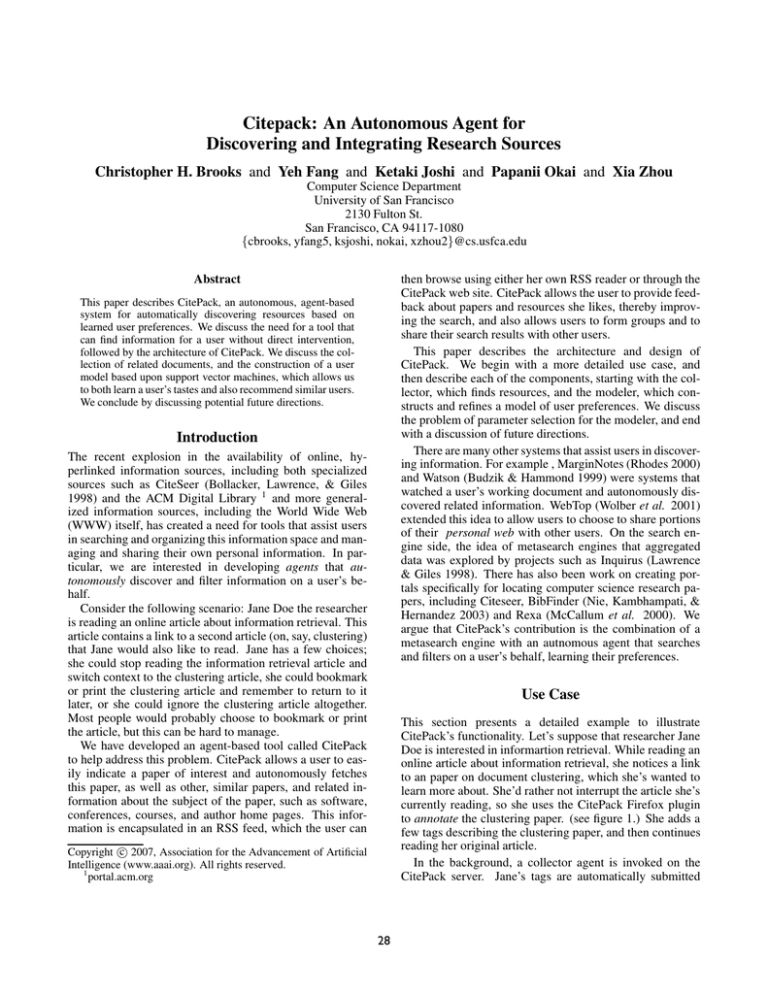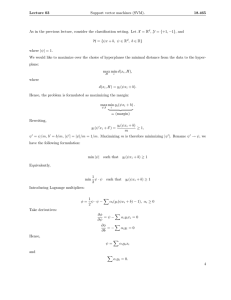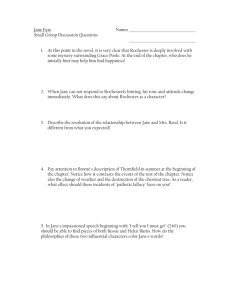
Citepack: An Autonomous Agent for
Discovering and Integrating Research Sources
Christopher H. Brooks and Yeh Fang and Ketaki Joshi and Papanii Okai and Xia Zhou
Computer Science Department
University of San Francisco
2130 Fulton St.
San Francisco, CA 94117-1080
{cbrooks, yfang5, ksjoshi, nokai, xzhou2}@cs.usfca.edu
then browse using either her own RSS reader or through the
CitePack web site. CitePack allows the user to provide feedback about papers and resources she likes, thereby improving the search, and also allows users to form groups and to
share their search results with other users.
This paper describes the architecture and design of
CitePack. We begin with a more detailed use case, and
then describe each of the components, starting with the collector, which finds resources, and the modeler, which constructs and refines a model of user preferences. We discuss
the problem of parameter selection for the modeler, and end
with a discussion of future directions.
There are many other systems that assist users in discovering information. For example , MarginNotes (Rhodes 2000)
and Watson (Budzik & Hammond 1999) were systems that
watched a user’s working document and autonomously discovered related information. WebTop (Wolber et al. 2001)
extended this idea to allow users to choose to share portions
of their personal web with other users. On the search engine side, the idea of metasearch engines that aggregated
data was explored by projects such as Inquirus (Lawrence
& Giles 1998). There has also been work on creating portals specifically for locating computer science research papers, including Citeseer, BibFinder (Nie, Kambhampati, &
Hernandez 2003) and Rexa (McCallum et al. 2000). We
argue that CitePack’s contribution is the combination of a
metasearch engine with an autnomous agent that searches
and filters on a user’s behalf, learning their preferences.
Abstract
This paper describes CitePack, an autonomous, agent-based
system for automatically discovering resources based on
learned user preferences. We discuss the need for a tool that
can find information for a user without direct intervention,
followed by the architecture of CitePack. We discuss the collection of related documents, and the construction of a user
model based upon support vector machines, which allows us
to both learn a user’s tastes and also recommend similar users.
We conclude by discussing potential future directions.
Introduction
The recent explosion in the availability of online, hyperlinked information sources, including both specialized
sources such as CiteSeer (Bollacker, Lawrence, & Giles
1998) and the ACM Digital Library 1 and more generalized information sources, including the World Wide Web
(WWW) itself, has created a need for tools that assist users
in searching and organizing this information space and managing and sharing their own personal information. In particular, we are interested in developing agents that autonomously discover and filter information on a user’s behalf.
Consider the following scenario: Jane Doe the researcher
is reading an online article about information retrieval. This
article contains a link to a second article (on, say, clustering)
that Jane would also like to read. Jane has a few choices;
she could stop reading the information retrieval article and
switch context to the clustering article, she could bookmark
or print the clustering article and remember to return to it
later, or she could ignore the clustering article altogether.
Most people would probably choose to bookmark or print
the article, but this can be hard to manage.
We have developed an agent-based tool called CitePack
to help address this problem. CitePack allows a user to easily indicate a paper of interest and autonomously fetches
this paper, as well as other, similar papers, and related information about the subject of the paper, such as software,
conferences, courses, and author home pages. This information is encapsulated in an RSS feed, which the user can
Use Case
This section presents a detailed example to illustrate
CitePack’s functionality. Let’s suppose that researcher Jane
Doe is interested in informartion retrieval. While reading an
online article about information retrieval, she notices a link
to an paper on document clustering, which she’s wanted to
learn more about. She’d rather not interrupt the article she’s
currently reading, so she uses the CitePack Firefox plugin
to annotate the clustering paper. (see figure 1.) She adds a
few tags describing the clustering paper, and then continues
reading her original article.
In the background, a collector agent is invoked on the
CitePack server. Jane’s tags are automatically submitted
c 2007, Association for the Advancement of Artificial
Copyright Intelligence (www.aaai.org). All rights reserved.
1
portal.acm.org
28
Figure 2: Related papers discovered by CitePack
discover other users with interests similar to Jane’s, and recommend their RSS feeds to her, thereby allowing her to find
out about resources and potential colleagues she might not
have been aware of.
Figure 1: Tagging a URL for use with CitePack
to del.icio.us 2 for sharing, and also stored in the CitePack
database. The collector then fetches references to the tagged
paper from CiteSeer and the ACM digital library, and then
crawls both of these sites to find other papers deemed to be
similar, either because of similar content or else because of
co-citation.
Once at least 50 candidate papes are discovered, this pool
of candidates is filtered by comparing them to a user model.
CitePack uses a support vector machine (SVM) (Joachims
2001) to construct a model of Jane’s preferences. Each candidate paper is passed through the SVM, which classifies the
paper as either “liked” or “not liked.” “Liked” papers are retained, and “not liked” papers are discarded.
CitePack then tries to find other information on the Web
related to this paper. Curently, we capture five types of information: related conferences, software, courses, books, and
author home pages. Online resources in each of these categories are retrieved and then passed through the SVM for
filtering.
Once all of this information has been gathered, an RSS
feed is generated. At her convenience, Jane can then view
this information, either through the RSS reader of her choice
or else via the CitePack website. (see figure 2.) The website
allows her to rate the resources Citepack has collected. This
information is then folded back into the SVM for further
training, thereby allowing it to make more accurate predictions in the future.
Jane can also create a group, allowing her to easily share
these resources with her colleagues. Any resources discovered by one group member will also be added to the group’s
RSS feed. (see figure 3). CitePack will also autonomously
2
Collector
When Jane tags and submits an article to CitePack, the first
component that is invoked is the collector. The collector is
a specialized crawler implemented on top of the Slashpack
framework (Brooks et al. 2006). The collector queries multiple information sources (currently Citeseer and the ACM
Digital Library) for references to this paper, and then begins
a breadth-first crawl on each site, following the “Find similar articles”, “related by co-citation”, and “related by similar
text” links.
One challenge the collector faces is the presence of nearduplicates. Many times this approach will find several
slightly different versions of a paper, such as a conference
version and a journal version. We suspect most users would
prefer only to see one version of the paper, so the others
must be detected and removed. We compute an MD5 hash of
each paper, which will detect exact duplicates, but not nearduplicates. To solve this problem, we use the well-known
technique of shingling (Broder et al. 1997). Shingling treats
each document as a string and computes a similarity based
on the overlap of the two strings.
We compared shingling to Naive Bayes as a technique for
detecting near-duplicates. Naive Bayes treats a document as
a “bag of words”, each of which has a conditional probability based on its frequency in a corpus of documents. We use
this to compute the probability that both documents belong
to the same class.
Naive Bayes is more efficient than shingling (O(n) vs
O(nlog(n/m))(Broder et al. 1997), but more prone to false
positives, as it does not consider word ordering or proximity.
For our problem, we found shingling to be more effective,
as two versions of a paper’s title or abstract often contained
http://del.icio.us
29
eter space to find the combination of parameters that performed best using n-fold cross-validation.
One question that came up along the way was whether to
use one set of parameters for all users, or whether to learn a
separate set of parameters for each user. Having separate parameters for each user was determined to produced a 9% improvement in accuracy. Examining the results, we found that
some users focused primarily on the author and title when
selecting papers, whereas other users focused primarily on
the abstract.
An advantage of using an SVM to learn user preferences
its ability to learn incrementally and incorporte new evidence. Each time a user tags a paper in CitePack, she is
presented with a list of recommendations and the opportunity to provide feedback for each of those recommendations.
Every time we receive 20 new recommendations, the SVM
is reconstructed, thereby improving the user model.
Discovering similar users
Once we have a user model, we can use this to discover
other users with similar preferences. We do this by constructing a virtual document for each user, consisting of all
papers that user has rated positively. We then construct a
vector model (Baeza-Yates & Ribiero-Neto 1999) for this
virtual document using the standard TFIDF weighting, in
which words that occur frequently in the virtual document
but rarely in all documents are given the most weight.
We then compare the vector models of each user with
both cosine similarity and the Jaccard measure (Baeza-Yates
& Ribiero-Neto 1999); all users within a system-defined
threshold are considered to be “similar enough” and recommended to Jane.
To date, this module has only been tested with synthetic
data, but has been able to accurately cluster users into four
groups based on the papers they’ve rated.
Figure 3: Related Groups and Users
identical substrings.
At this point, we keep the most recent version of the paper; future extensions would allow a user to specify a preference, such as journal articles over conference papers.
Once at least 50 pages have been collected, the collector
then invokes the modeler to filter these papers based on the
user’s preferences.
User Modeling
Following “related” links is a great way to find other resources that are similar to Jane’s original paper, but it leaves
out some crucial information: all of the other papers Jane
has tagged in the past. This can potentially give us a lot of
other data about Jane’s interests, and help to eliminate papers not of interest to her.
We model a user’s preferences using a support vector
machine (SVM). A detailed discussion of the workings of
SVMs and their application to text classification is beyond
the scope of this paper, but can be found in Joachms, et
al (Joachims 2001). In short, an SVM treats a document
as a weighted vector, and constructs a hyperplane that separates papers indicated as “liked” from papers indicated as
“not liked.” This hyperplane can then be used to easily classify unseen papers based on their position with respect to the
hyperplane. We used Joachims’ svmlight library (Joachims
1999) for this task.
Applying SVMs to this task of document classification is
not without its challenges. The typical paper has many features, of which we considered four: author, abstract, title,
and user-assigned tags. svmlight requires the user to indicate the relative importance of these features, which meant
that we needed to perform a separate set of experiments to
determine the weight that should be assigned to each of these
features. We did this by having a set of users each rate at
least 50 papers and then exhaustively searching the param-
External Resources
Finally, the collector is used to also discover other resources
that Jane might be interested in. Currently, we consider five
types of resources: books, software, webpages for courses,
author home pages, and webpages for conferences. In all
five cases, we take the approach of automatically constructing a search query for use with an existing Web Service provided by either Google or Amazon.
The interesting challenge is in forming this query. Our
first approach was to use the relevant words in the title of
the paper. However, these are often far too specific to yield
meaningful results. For example, a user who has tagged the
paper “ A Statistical Learning Model of Text Classification
with Support Vector Machines” might be interested in conferences on information retrieval, data mining, or machine
learning, even though none of those phrases are in the title.
We chose to solve this problem by constructing a taxonomic classifier derived from the ACM Computing Classification system. This system subdivides computer science
into a number of areas and subareas, with specialized keywords at the “leaves” in the taxonomy. Once we determine
30
References
the appropriate leaves for the title in question, we then replace them with the more general category terms extracted
from the taxonomy. We consider all one, two, and threeword phrases within the title in doing so.
For example, for the paper “A Statistical Learning Model
of Text Classification with Support Vector Machines”, we
would use the taxonomic classifier to predict categories
for every one-word, two-word, and three-word substring
of the title. This would produce matches for “Learning”, “Text Classification”, and “Support Vector Machines”,
which would be mapped to “Learning,” “Information Storage and Retrieval,” and “Pattern Recognition.”
These new, more general terms are then used as the basis
for queries that are sent to Google and Amazon. Each query
is also augmented with additional keywords that help identify the particular type of information (for example, “Call
for Papers” for conferences, “home page” for home pages,
or “sourceforge” for software). The resulting URLs are then
passed off to the SVM for filtering, just as with papers.
Baeza-Yates, R., and Ribiero-Neto, B. 1999. Modern Information Retrieval. Addison-Wesley.
Bollacker, K.; Lawrence, S.; and Giles, C. L. 1998.
CiteSeer: An Autonomous Web Agent for Automatic Retrieval and Identification of Interesting Publications. In
Sycara, K. P., and Wooldridge, M., eds., Proceedings of the
Second International Conference on Autonomous Agents,
116–123. New York: ACM Press.
Broder, A. Z.; Glassman, S. C.; Manasse, M. S.;
and Zweig, G.
1997.
Syntactic Clustering of
the Web.
Technical Report 1997-015, Systems
Research Center, Palo Alto, CA.
Available at
http://gatekeeper.research.compaq.com/pub/DEC/SRC/technicalnotes/SRC-1997-015-html/.
Brooks, C. H.; Agarwal, M.; Endo, J.; King, R.; Montanez,
N.; and Stevens, R. 2006. Slashpack: An Integrated Toolkit
for Gathering and Filterng Hypertext Data. In Proceedings
of the 21st National Conference on Artificial Intelligence
(AAAI-06).
Budzik, J., and Hammond, K. 1999. Watson: Anticipating
and Contextualizing Information Needs. In 62nd Annual
Meeting of the American Society for Information Science.
Joachims, T. 1999. Making large-Scale SVM Learning
Practical. In Schlkopf, B.; Burges, C.; and Smola, A., eds.,
Advances in Kernel Methods - Support Vector Learning.
MIT Press.
Joachims, T. 2001. A Statistical Learning Model of Text
Classification with Support Vector Machines. In Proceedings of the Conference on Research and Development in
Information Retrieval (SIGIR). ACM Press.
Lawrence, S., and Giles, C. L. 1998. Context and Page
Analysis for Improved Web Search. IEEE Internet Computing 2(4):38–46.
McCallum, A.; Nigam, K.; Rennie, J.; and Seymore, K.
2000. Automating the Contruction of Internet Portals with
Machine Learning. Information Retrieval Journal 3:127–
163.
Nie, Z.; Kambhampati, S.; and Hernandez, T. 2003.
Bibfinder/statminer: Effectively mining and using coverage and overlap statistics in data integration. In Proceedings of VLDB 2003.
Rhodes, B. 2000. Margin Notes: Building a Contextually Aware Associative Memory. In Proceedings of the
2000 International Conference on Intelligent User Interfaces, 219–224. ACM.
Wolber, D.; Witchell, J.; Kepe, M.; and Ranitovic, I. 2001.
Exposing Document Context in the Personal Web. In
Proceedings of the International Conference on Intelligent
User Interfaces (IUI), 2001.
Future Work
Currently, we feel that CitePack is in the alpha stage. One
thing that is needed from a software development standpoint
is a scaling up of the number of users. Currently, it’s been
vetted primarily by students at USF, which has limited the
generality, as well as the number of users. A larger user
study will allow us to evaluate CitePack “in the wild” and
determine whether it is truly a useful tool.
We are also interested in integrating CitePack with other
resources that allow “people tracking”, such as Peoplicious 3
and linkedIn 4 . This will allow us to more easily relate authors to papers, and discover other resources that might be of
interest to a user, such as other people at the same institution,
or advisors, or emloyees.
We would also like to add other data sources to CitePack.
Currently, the biggest limitation to this has been the fact
that many services, such as Google Scholar 5 , explicitly forbid software agents from accessing their services. (While
there are several applications that use Google Scholar results
through screen-scraping, this would appear to be a violation
of their terms of use.)
Conclusions
This paper has described the design and implementation of
Citepack, a system allows users to easily annotate papers of
interest and then discovers other resources realted to these
papers. CitePack incrementally learns a model of user preferences using a support vector machine and uses this model
to filter potentially interesting papers and match users with
others who have similar interests. Useful references are
compiled into an RSS feed, allowing the user to browse them
at her convenience.
3
www.peoplicious.com
www.linkedin.com
5
scholar.google.com
4
31





